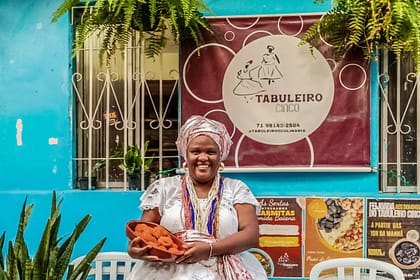This story references discussions held during the 8th edition of Moveee’s monthly live culture panel, The Platform, which features Theo Allanso, Emmy Egwemi and Jonathan Adamu, in conversation with Timileyin Okunlola about the intersection of art and community in Nigeria’s contemporary art ecosystem from the young curators’ perspective. You can watch the event unedited replay here.
The vibrant hum of Nigeria’s contemporary art scene often spotlights its dazzling artists and the burgeoning collector base. Yet, behind every compelling exhibition, every thought-provoking display, there stands a figure whose role is as multifaceted as the art itself: the curator. Far from being mere custodians of artworks, these individuals are the unsung architects of vision, blending creative storytelling with astute business acumen in an art market that is both burgeoning and besieged by unique challenges.
The very essence of curatorial practice, as articulated by Theo Allanso, art manager at Windsor Gallery Abuja, is to “translate an artist’s work for an audience to kind of consume.” This seemingly simple act belies a complex process, one that Allanso reveals has expanded to include intricate exhibition design and even elements typically handled by gallerists. From conceptualising annual programming and identifying overarching themes to meticulously selecting artists whose works embody those ideas, the curator’s hand is everywhere. It’s a journey that extends well beyond the exhibition’s opening, encompassing everything from organising artist talks to the critical task of producing catalogues for historical documentation.
This notion of translation is echoed by Emmy Egwemi, who beautifully describes curating as a “creative strategic storytelling.” For Egwemi, it’s about forging a profound connection between “the artist’s voice with the audience’s perception,” all within a broader context that might be cultural, historical, or deeply emotional. This narrative approach transforms a collection of individual pieces into a coherent, impactful experience for the viewer.
What’s striking is how many curators stumble into this demanding profession through unconventional paths. Both Allanso and Egwemi, for instance, found their initial grounding in theatre. Egwemi humorously recalls starting as an “errand boy for an art collector who is also into tech,” tasked with researching artists for their investment potential. It was only later, when a third party referred to him as “the curator” for a co-working space he had helped design, that he realised he had been performing curatorial duties all along. This hands-on, almost accidental immersion allowed him to develop a unique vantage point, enabling him to “see the business side of the art and also the creative side of it too.” This dual perspective is increasingly vital in a global art market driven by both aesthetic appreciation and financial speculation.
Allanso’s journey similarly began in theatre and art history. He credits his theatrical background with cultivating the storytelling instinct essential to curation. His first major show, “In Living Colour,” exemplified this, as he wove the artist Moyosore Jolaolu’s distinctive palette knife technique – creating an image from “different blocks of colour that come together” – into a narrative about “remembering” and piecing together disparate elements. This highlights how a curator’s personal intellectual framework can deeply inform the thematic direction of an exhibition.
For those aspiring to enter this field, the advice from curators is clear: get your hands dirty. Jonathan Adamu, a curator and artist himself, strongly advises visiting existing galleries and art spaces to observe diverse curatorial approaches. “The best way to understand something is to see from other people who have done it before,” he asserts. He also stresses the importance of seeking mentorship and, crucially, engaging in relentless research to deepen one’s understanding of the craft.
The curator’s role extends beyond the artistic realm into the sharp-edged world of commerce. As Egwemi aptly puts it, while artists are consumed with creation, curators must consider “how an artist’s piece is marketable to the art ecosystem.” This involves understanding that buyers are motivated by both “aesthetic purposes” and “investment.” The curator, therefore, becomes the persuasive storyteller, shaping a narrative that not only highlights the art’s intrinsic beauty but also its financial viability and potential for appreciation.
Allanso meticulously breaks down the financial realities: the significant overheads of running a gallery – salaries, rent, installation costs, marketing – combined with commission splits with artists, leave surprisingly thin profit margins. This challenging economic landscape is forcing a re-evaluation of traditional gallery models, a point underscored by the recent shift of ADA Contemporary Art Gallery, a prominent Accra-based gallery, to a digital-first, pop-up model. This mirrors global trends where smaller galleries are often struggling to compete with larger institutions and the ever-growing influence of online platforms.
The power dynamics within the global art market are another critical aspect. Allanso highlights the historical dominance of “the European and the American markets” in dictating art values, with Asian markets increasingly asserting their influence. The current global economic instability, he notes, has hit the luxury art market hard. “Art being a luxury isn’t something that people prioritise,” he explains, leading to a significant drop in sales, even after the surge of interest in Black and African artists post-Black Lives Matter.
This has ignited a crucial conversation about fostering a self-sustaining “African art ecosystem where you have art being moved around Africa and funds kind of remaining on the continent.” This aspiration is deeply intertwined with a broader movement to decolonise the art world, challenging the historical biases that have often undervalued or misrepresented African art. As Jonathan Adamu notes, a deeply rooted, colonial-era perception of African art as “fetish” continues to hinder its valuation within Nigeria itself. “People don’t value art because they don’t understand it,” he argues, emphasising the need for greater art education and appreciation within the local populace. The ongoing fight for the repatriation of looted African artefacts, like the Benin Bronzes, is another facet of this decolonisation effort, aiming to reclaim cultural heritage and narratives.
Despite the monumental challenges, the passion that drives curators remains palpable. When asked about the most daunting and fulfilling aspects of their work, the answers reveal a shared dedication. Allanso finds immense satisfaction in the moment an exhibition is finally installed, a testament to months of effort, and in seeing people “really resonate with the exhibition.” The bitter pill, however, is witnessing a deeply impactful show fail to generate sales. Jonathan Adamu echoes the sentiment, identifying “funding” as the most daunting hurdle, a common refrain among independent cultural practitioners in regions with limited government support. Yet, the reward lies in seeing “people interact with the story that has been told, seeing it resonate with them.” It’s the ultimate validation of a curator’s ability to connect art with the human experience.
Ultimately, curating in Nigeria, as eloquently described by Allanso, is a “labour of love.” It’s a profession where significant monetary gain may not be immediate, taking a decade or more to truly see the “fruit of your labour.” Jonathan Adamu paints a stark picture: “As a curator, the first one to two years, you might realise that you’re spending more money than you’re making.” Yet, the intangible rewards – the networks built, the stories told, the cultural impact – are what sustain these visionaries. In a world increasingly driven by digital consumption, the curator remains essential, a human bridge between the raw power of artistic expression and the discerning eye of the audience, continuing to shape narratives and redefine the very meaning of art in a rapidly evolving global landscape.








